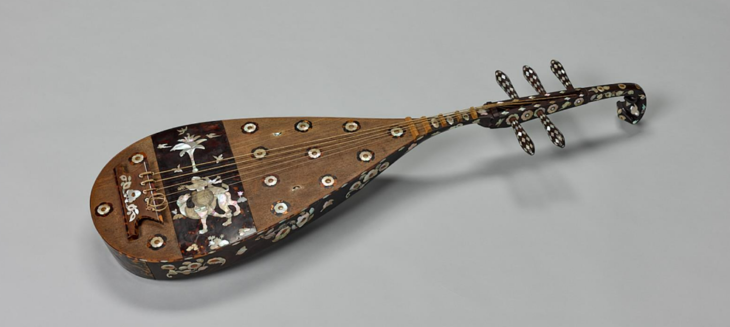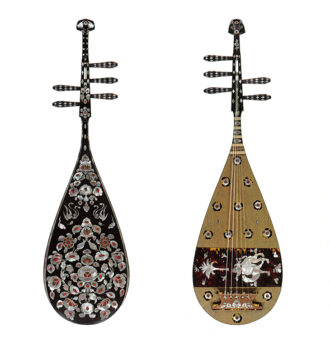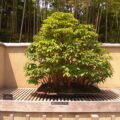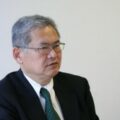The Fascinating World of “Reproduction-imitations”

Five-stringed biwa lute of shitan with mother-of-pearl inlay
A reproduction-imitation created based on this original was introduced at the exhibition “The Reproduction of Shosoin Treasures Encountering Tenpyo Craftsmanship through the Recreation of 8th Century Works.” The biwa was called “Red Sandalwood Five-String Biwa Lute with Mother-of-Pearl Decoration” at the exhibition.
PHOTO: Office of the Shosoin Treasure House, Imperial Household Agency
Takashina Shuji, Director of the Ohara Museum of Art and President of the Western Art Foundation

Takashina Shuji, Director of the Ohara Museum of Art and President of the Western Art Foundation
From late January to March 2022, a special exhibition titled “Celebrating the Enthronement Ceremonies of His Majesty the Emperor”: The Reproduction of Shosoin Treasures—Encountering Tenpyo Craftsmanship through the Recreation of 8th Century Works” was held at the Suntory Museum of Art in Roppongi, Minato, Tokyo. The exhibition literature includes a rather unfamiliar phrase that translates as “Reproduction-imitation.” What on earth does this term mean?
The Shosoin[1] Treasures include items linked to Emperor Shomu, as well as related documents and craft objects of value. The Shosoin treasure house was built as a store for these treasures. The management and storage of the treasures was strict, requiring imperial sanction before items could leave the store, and this imperial seal system continues today. In hot and humid Japan, “airing out” was a necessary part of managing the treasures, so every year when that happened, an “Exhibition of Shosoin Treasures” was held to put the treasures on public show.
These days, however, the treasures are stored in temperature- and humidity-controlled warehouses, so there is no need for airing out. But since the Meiji period (1868–1912), a large-scale systematic repair project has been in place to check the state of preservation of all the treasures and repair any defects that are found. Meanwhile, as another way of preserving and passing on these unique cultural properties, a project is in progress to produce replicas of the original treasures using the same materials and techniques as in the Tenpyo period (710–794). In other words, it is a project to create other “real” objects, or second originals.
Nishikawa Akihiko, former Director of the Office of the Shosoin Treasure House, who has been involved with researching and helping conserve the Shosoin Treasures for many years, responded to an interview by a curator of the Suntory Museum of Art.
“The main aim is to use them as substitutes for public displays, but… in the process of actually making them, we can learn things of great significance about ancient forms and techniques. Not just the same forms, but also the same materials, structures, and techniques are used to reproduce the treasures as they originally were. That is different from perfectly copying a form, and since the term ‘imitation’ gives a rather bad impression, we devised a new term, ‘reproduction-imitation,’ to better reflect the true meaning.
“Whether it is calligraphy or craft works, if you copy only by imitating and tracing lines, the energy of the piece disappears,” added Nishizawa. “Only through very careful observation, repeated practice, acquisition of technique, and memorization by the body can we express the essence of the original’s spirit and charm.”

Front view (right) and back view (left) of the reproduction-imitation of Five-stringed biwa lute of shitan with mother-of-pearl inlay (as Red Sandalwood Five-String Biwa Lute with Mother-of-Pearl Decoration at the exhibition (By Sakamoto Kyokusai III, woodwork; Nitta Kiun, inlay; Kitamura Shosai and Matsuura Naoko, decoration; and Marusan Hashimoto Co., strings) 2011‒2018 (Heisei 23-30)
PHOTO: Office of the Shosoin Treasure House, Imperial Household Agency
It really is an attempt to create a second “original.” For example, a good case in point is the reproduction-imitation of “Five-stringed biwa lute of shitan with mother-of-pearl inlay,” which is the star of the exhibition. The main material of the body, red sandalwood, is originally from India and was extremely rare. What’s more, it had to be imported as a log because a thickness of 30 cm or more is needed when making a biwa. In the Tenpyo period, there was no machinery such as cranes, so the hefty logs had to be transported to Japan through human power.
Also, the gorgeous decoration covering the entire surface of the biwa includes raden (mother-of-pearl inlay) and taimai (hawksbill turtle shell). These were also extremely rare in ancient times, and the necessary materials wouldn’t have been easy to get hold of. There’s no doubt that the craftsmen of the Tenpyo period must have started by struggling to acquire the materials. In making the reproduction-imitation, the silk strings were key to the instrument’s sound. Koishimaru silk cocoons, a native Japanese breed of cocoon grown at the Momijiyama Sericultural Station in the Imperial Palace, were used because they are the closest to ancient cocoons and suitable for strings. To make best use of their special characteristics, they were spun and twisted into string. Naturally, all the work was done by hand.
Only the original Shosoin Treasures can serve as models. The five-stringed biwa is originally from India and its existence was known through Chinese written materials. However, all such biwa have been lost, and the treasure housed at the Shosoin is the world’s only extant piece. In that sense too, the making of this reproduction-imitation is very significant. It is nothing other than a living witness to the history of cultural exchange in the East Asian region, which encompasses India, mainland China, the Korean peninsula, and Japan. And that’s not all. The existence of the original treasure sheds much light not just on cultural exchange but also on the history of cultural transmission.
It is said that the five-stringed biwa was once greatly loved in China and played on various occasions. Bai Juyi (Bai Letian), the most loved Tang dynasty poet during the Japanese dynastic period [or Heian period, 794–1185], wrote a lengthy ancient poem in seven-syllable lines titled “Pipa Xing” (Song of the Lute). The poem is renowned for its wonderful description of the ethereal sounds of biwa playing, and one of its lines is, “She turned the pegs and plucked each string two or three times.” The line refers to the musician winding the tuning pegs, adjusting the tension of the strings, and playing the strings with the plectrum to test them.
Although I do understand the meaning of the phrase, I don’t know how or in what manner the performance took place. In the first place, I don’t understand the role of the plectrum. In mainland China, biwa performances were still very popular after the Tang dynasty (618–907), but the method of playing the instrument shifted at some point, and it came to be played with the fingertips not a plectrum. It’s what we call strumming. With that, the meaning of “plucked” strings became obscure, and even the plectrum itself was forgotten. And so, it was only natural that the meaning of Bai Juyi’s “Pipa Xing” would also be lost.
However, in the Shosoin there remains the “Red-Stained Ivory Bachi Plectrums with Bachiru Carved Designs,” the name given in the Kokka Chinpo Cho (List of the Nation’s Rare Treasures), which accompanies the “Red Sandalwood Five-String Biwa Lute with Mother-of-Pearl Decoration.” It is gorgeously decorated using the “bachiru” technique, in which the surface of the red-stained ivory is engraved, revealing a white base and allowing a design to appear via the surface’s contrasting colors. The reproduction-imitation of this is also part of the current exhibition.
Incidentally, the Heike biwa, Satsuma biwa, Chikuzen biwa, blind monk biwa, and other biwa instruments traditional in Japan since ancient times, and all once known as huqin (any Chinese string instrument played with a bow), are also played with a plectrum. If one thinks of a shamisen performance, it is easy to understand that the tradition of playing stringed instruments by both bowing and plucking has not been lost in Japan, and has been handed down through the years. Japanese people immediately know what kind of action “turning the pegs and plucking each string two or three times” in Bai Juyi’s poem is.
This was the backdrop to the project to create a reproduction-imitation of the “Red Sandalwood Five-String Biwa Lute with Mother-of-Pearl Decoration” of the Shosoin Treasures. Says Nishikawa, “We started the preliminary research in 2002, began creating the actual reproduction in 2011, and completed it in 2019.” It was a major project that actually lasted around 17 years.
During the actual creation of the biwa, many skilled artisans worked together, with contemporary lacquer artists and experts in the reproduction of paintings cooperating on the decorative mother-of-pearl inlay and tortoiseshell, while experts in foreign woods were in charge of carving the wood to inlay the decoration. The project really did bring together all the skill of the Japanese craft world.
The exhibition at the Suntory Museum of Art also showcases the process of creating reproduction-imitation through photographs and other documents. The result is that, not only have the treasures themselves been “reproduced,” but so too have the Tenpyo period craft techniques of 1,300 years ago. In fact, as well as the reproduced five-stringed biwa, the hall is filled with exquisite and refined music played on the reproduced biwa. When inside the hall, visitors are instantly captivated by a world of ancient beauty. If “art” is the bringing together of a splendid sense of beauty that transcends the everyday, as well as impeccable and strict craft technique, then we can call this exhibition of reproduction-imitations a truly outstanding exhibition of art.
Translated from “‘Saigen-mozo’ no Miwaku no Sekai (The Fascinating World of “Reproduction-imitations”),” Asteion, Vol. 096 2022, pp. 104-107. (Courtesy of CCC Media House Co., Ltd.) [August 2022]
Keywords
- Takashina Shuji
- Ohara Museum of Art
- Western Art Foundation
- Reproduction of Shosoin Treasures
- Shosoin treasure house
- Todai-ji
- Encountering Tenpyo Craftsmanship
- Tenpyo period
- Suntory Museum of Art
- reproduction-imitation
- Nishikawa Akihiko
- Red Sandalwood Five-String Biwa Lute with Mother-of-Pearl Decoration
- biwa lute
- shamisen
- Bai Juyi (Bai Letian)
- Pipa Xing
- Song of the Lute
- tuning pegs
- plectrum




